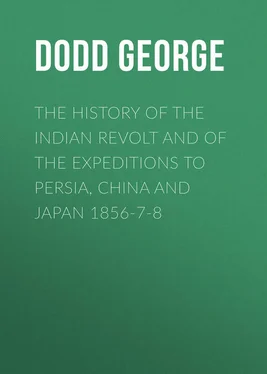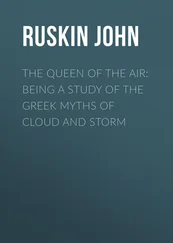George Dodd - The History of the Indian Revolt and of the Expeditions to Persia, China and Japan 1856-7-8
Здесь есть возможность читать онлайн «George Dodd - The History of the Indian Revolt and of the Expeditions to Persia, China and Japan 1856-7-8» — ознакомительный отрывок электронной книги совершенно бесплатно, а после прочтения отрывка купить полную версию. В некоторых случаях можно слушать аудио, скачать через торрент в формате fb2 и присутствует краткое содержание. Жанр: foreign_antique, foreign_prose, на английском языке. Описание произведения, (предисловие) а так же отзывы посетителей доступны на портале библиотеки ЛибКат.
- Название:The History of the Indian Revolt and of the Expeditions to Persia, China and Japan 1856-7-8
- Автор:
- Жанр:
- Год:неизвестен
- ISBN:нет данных
- Рейтинг книги:3 / 5. Голосов: 1
-
Избранное:Добавить в избранное
- Отзывы:
-
Ваша оценка:
- 60
- 1
- 2
- 3
- 4
- 5
The History of the Indian Revolt and of the Expeditions to Persia, China and Japan 1856-7-8: краткое содержание, описание и аннотация
Предлагаем к чтению аннотацию, описание, краткое содержание или предисловие (зависит от того, что написал сам автор книги «The History of the Indian Revolt and of the Expeditions to Persia, China and Japan 1856-7-8»). Если вы не нашли необходимую информацию о книге — напишите в комментариях, мы постараемся отыскать её.
The History of the Indian Revolt and of the Expeditions to Persia, China and Japan 1856-7-8 — читать онлайн ознакомительный отрывок
Ниже представлен текст книги, разбитый по страницам. Система сохранения места последней прочитанной страницы, позволяет с удобством читать онлайн бесплатно книгу «The History of the Indian Revolt and of the Expeditions to Persia, China and Japan 1856-7-8», без необходимости каждый раз заново искать на чём Вы остановились. Поставьте закладку, и сможете в любой момент перейти на страницу, на которой закончили чтение.
Интервал:
Закладка:
What are the authoritative or official divisions of the country in reference to the governors who control and the soldiers who fight (or ought to fight) for it? What are the modes in which a vast region, extending more than a thousand miles in many different directions, is or may be traversed by rebel soldiers who fight against their employers, and by true soldiers who punish the rebels? What and who are the soldiers thus adverted to; how many, of what races, how levied, how paid and supported, where cantoned, how officered? These are the three subjects that will occupy a brief chapter; after which the narrative of the Revolt may with profit be at once entered upon.
And first, for India as an immense country governed by a people living eight or ten thousand miles distant. Talk as we may, there are few among us who can realise the true magnitude of this idea – the true bearing of the relation borne by two small islands in a remote corner of Europe to a region which has been famed since the time of Alexander the Great. The British Empire in India – what does it denote? Even before the acquisition of Oude, Pegu, and Nagpoor, the British possessions in India covered nearly 800,000 square miles; but as the influence of England is gradually extending over the protected and the hitherto independent states, we shall best conceive the whole (without Pegu, which is altogether eastward of what is considered India) as a compact territory of 1,400,000 square miles – twelve times as large as the United Kingdom, sixteen times as large as Great Britain, twenty-five times as large as England and Wales: double the size, in fact, of Great Britain, France, Spain, Portugal, Italy, Belgium, Holland, Prussia, and Switzerland, all combined. Nor is this, like the Russian Empire, a vast but thinly populated region. It contains at least a hundred and eighty millions of human beings, more than a hundred and thirty millions of whom are the direct subjects of Queen Victoria – that is, if anything can be direct, connected with the anomalous relations between the Crown and the East India Company.
It comes within the knowledge of most intelligent English readers at the present day, that this Indian Empire, governed by a curiously complicated bargain between a sovereign and a company, has been growing for a hundred years, and still continues growing. In fits of national anger or international generosity, we inveigh against the Czar of Russia for processes of aggression and plans of annexation in regions around and between the Caspian and Black Seas, and we compassionate and assist his weak neighbours under the pressure of his ambition; but it is only in times of excitement or peril that we consider the extraordinary way in which our own Indian Empire has been built up – by conquest, by purchase, by forfeiture – and in some cases by means which, called robbery by our enemies, do at any rate demand a little compunction from us as a Christian people. Exactly a century ago, England scarcely occupied a foot of ground in India; her power was almost crushed out by the native nawab who rendered himself infamous by the episode of the Black Hole at Calcutta; and it was in the year after that atrocity – namely, in 1757, that Clive began those wonderful victories which established a permanent basis for a British Empire in Hindostan. And what a continuous growth by increment has since been displayed! The Pergunnahs, Masulipatam, Burdwan, Midnapore, Chittagong, Bengal, Bahar, the Northern Circars, Benares, all passed into British hands by the year 1775; the next twenty-five years brought to us the ownership of Salsette, Nagore, Pulo Penang, Malabar, Dindigul, Salem, Barramahal, Coimbatore, Canara, Tanjore, and portions of the Deccan and Mysore; in the first quarter of the present century the list was increased by the Carnatic, Gorukhpore, the Doab, Bareilly, portions of Bundelcund, Cuttack, Balasore, Delhi, Gujerat, Kumaon, Saugor, Khandeish, Ajmeer, Poonah, the Concan, portions of Mahratta country, districts in Bejapore and Ahmednuggur, Singapore, and Malacca; in the next period of equal length the acquisitions included Assam, Aracan, Tenasserim, the Nerbudda districts, Patna, Sumbhulpore, Koorg, Loodianah, Kurnaul, Sinde, and the Jullundur Doab; while during the eight years of the Marquis of Dalhousie’s administration, as we learn on his own authority, there were added Pegu, the Punjaub, Nagpoor, Oude, Satara, Jhansi, and Berar – all these in exactly a century.
The whole of British India is placed under a governor-general, whose official residence is at Calcutta, and who is assisted by a kind of cabinet or council of ministers. Formerly there were three presidencies, under whom the whole territory was placed; two being under the governors of Bombay and Madras, and the remainder, called the Bengal presidency, being under the governor-general himself, who was to this extent vested with a special as well as a general government. But in process of time it was found impossible for this official to fulfil all the duties imposed upon him; and the great Bengal presidency became subdivided. There are now five local governors of great districts – the governor-general himself, who directly rules many of the newly acquired regions; the lieutenant-governor of the Northwest Provinces, who rules some of the country formerly included in the presidency of Bengal; the lieutenant-governor of the Lower Provinces, who rules the rest of that country; and the governors of Madras and Bombay, whose range of territory has not undergone much increase in recent years. Let us learn a little concerning each of these five.
Madras, as a presidency or government, includes the whole of the south of India, where its narrowed, peninsular form is most apparent, up to about latitude 16° north, together with a strip still further north on the east or Coromandel coast. Its greatest inland extent is about 950 miles in one direction, and 450 in another; while its shores are washed by the Indian Ocean and the Bay of Bengal along a coast-line of no less than 1700 miles – unfortunately, however, very ill provided with ports and anchorages. There are about thirty districts and states under the governor’s rule – some as ‘regulation districts,’ others as ‘non-regulation districts,’ and others as ‘native states.’ The difference between these three kinds may be thus briefly indicated: the ‘regulation’ districts are thoroughly British, and are governed directly by the chief of the presidency; the ‘non-regulation’ districts are now equally British, though of more recent acquisition, but are governed by agents or commissioners; while the ‘native states’ have still their native princes, ‘protected,’ or rather controlled by the British. Without any formal enumeration, it may be well to remember that the following names of some of these districts, all more or less familiar to English readers as the names of towns or provinces, are included among those belonging to the presidency or government of Madras – Masulipatam, Nellore, Chingleput, Madras, Arcot, Cuddalore, Cuddapah, Salem, Coimbatore, Trichinopoly, Tanjore, Madura, Tinnevelly, Malabar, Canara, Vizagapatam, Kurnaul, Koorg, 2 2 A young native princess was sent to England from this district to be educated as a Christian lady; and Queen Victoria became a sponsor for her at a baptismal ceremony.
Cochin, Mysore, Travancore. Some of these are not absolutely British; but their independence is little more than a name. There are various important towns, or places worth knowing in connection with Indian affairs, which are included in some or other of these districts, but not giving their names to them – such as Seringapatam, Golcandah, Rajamandry, Juggernaut, Vellore, Pulicat, Pondicherry (French), Tranquebar, Negapatam, Bangalore, Ootacamund, Mangalore, Calicut.
Bombay, as a presidency, is a curiously shaped strip. Exclusive of the subordinate territories of native princes (over which, however, the Company exercises paramount political sway) and of Sinde, which, though recently placed under the government of Bombay, may properly be regarded as a distinct territory – exclusive of these, the presidency occupies a narrow strip, of irregular outline, stretching for a considerable distance north and south. It occupies the western coast of the peninsula, from Gujerat on the north, to the small Portuguese settlement of Goa on the south; and has a length of 650 miles, with a maximum breadth of 240. The Bombay provinces included in the strip just noticed, the neighbouring territories administered by or on behalf of native princes, and Sinde, form three sections about equal in size, the whole collectively being thrice as large as England and Wales. To assist the memory, as in the last paragraph, we give the names of the chief districts likely to be known to English readers – all of which either belong absolutely to the presidency of Bombay, or are more or less under the control of the governor – Surat, Baroche, Ahmedabad, Khandeish, Poonah, Ahmednuggur, Bombay, Concan, Satara, Baroda, Kattywar, Kolapore, Cutch, the Mahratta districts, Kurachee, Hyderabad, Shikarpore, Khyrpore. The last four are districts of Sinde, conquered by the late Sir Charles James Napier, and placed under the Bombay presidency as being nearer at hand than any of the others. Besides the towns similarly named to most of these districts, the following may be usefully mentioned – Goa (Portuguese), Bejapore, Bassein, Aurungabad, Assaye, Nuseerabad, Cambay.
Читать дальшеИнтервал:
Закладка:
Похожие книги на «The History of the Indian Revolt and of the Expeditions to Persia, China and Japan 1856-7-8»
Представляем Вашему вниманию похожие книги на «The History of the Indian Revolt and of the Expeditions to Persia, China and Japan 1856-7-8» списком для выбора. Мы отобрали схожую по названию и смыслу литературу в надежде предоставить читателям больше вариантов отыскать новые, интересные, ещё непрочитанные произведения.
Обсуждение, отзывы о книге «The History of the Indian Revolt and of the Expeditions to Persia, China and Japan 1856-7-8» и просто собственные мнения читателей. Оставьте ваши комментарии, напишите, что Вы думаете о произведении, его смысле или главных героях. Укажите что конкретно понравилось, а что нет, и почему Вы так считаете.












